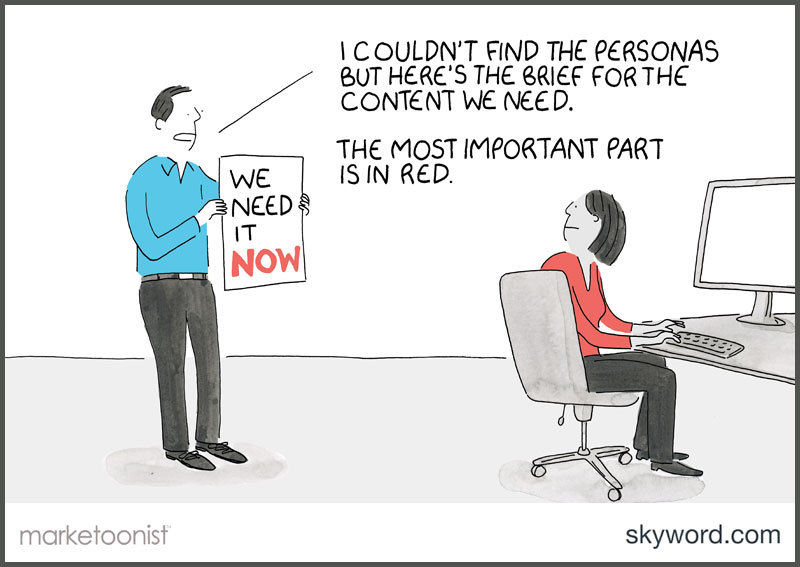Content Strategy
The Seven Needs of the Content-Centric Marketing Organization, Part One: Strategize
By Rachel Haberman on October 22, 2018
This article is Part One of a series on the needs of a content-centric marketing organization. Read the full series for more coverage.
It should come as absolutely no surprise that a solid content strategy-the why and the how of any successful content operation-is the first, and in many ways the most important, determinant of success for content marketing. After all, without a strategy to guide their decisions, how can marketers have any confidence that their content will help them achieve their desired outcomes? How can they argue for the budget they need, or ensure they are aligned with larger business goals?
And so it's an altogether unwelcome surprise that, according to the Content Marketing Institute's 2018 research, a mere 37 percent of B2B and 38 percent of B2C marketers have a documented content strategy.
What the heck is going on here?

Why We (Willfully) Overlook Content Strategy
Consider the landscape in which most marketing departments are operating. The unit by which most marketers understand and organize our marketing is the campaign: a specific message delivered during a set period of time whose goal is to drive the target audience to take a specific action. If content marketing is simply one more channel through which a campaign is broadcast, then content strategy is by definition a piecemeal affair, rewritten according to the needs of each campaign. It's no wonder then that busy marketers aren't taking the time to document an overarching content strategy when, in this scenario, it isn't what's driving content creation.
A more sophisticated approach to content marketing-content-centric marketing, if you will-is to take content not as just another channel but as an approach to marketing as a whole, centered on delivering exceptional customer experiences through excellent content. This approach is by its very nature always on and multichannel, and because it transcends individual campaigns, it requires a different take on strategy.
But What Is Content Strategy, Anyway?
The building blocks of content strategy will be familiar to anyone who has put together a campaign; where they diverge is largely a question of scale. Because a campaign is timebound, it encompasses a limited set of content assets. An always-on content strategy needs to account for a potentially open-ended pool of content, and so it needs to fuel ongoing content creation and distribution. What's more, a campaign is meant to sunset after a certain time period, whereas evergreen content assets can continue to drive compounding value over their lifetime.
Image attribution: Raw Pixel
So then, what is content strategy? At its simplest and most basic, it comprises personas, stages of the customer journey, and a plan for how content will address the needs of those personas at each stage of that journey.
Personas
Knowing who you want to reach with your content is the jumping-off point for every content-related decision. The good news? Almost every marketing strategy starts here, so it's likely you already have this information documented. And if not, a reasonably simple starting place is to profile your best customers. What defining characteristics do they share? What conclusions can you draw about them based on what you know about their needs and values?
Stages
Complementing the personas are the steps those personas will take in their path to purchase and beyond. What are they looking for at each step of the journey? What questions do they need answered, and where will they turn for that information?
Addressing Customer Needs
The nexus of these personas and the stages of the customer journey is a fertile place for content ideation, generating a potentially limitless pool of topics to pull from. Even this simple, back-of-the-envelope content strategy ensures that each piece of content is not a stand-alone project but instead part of a larger content experience designed to address the customer's needs.
Image attribution: Miguelangel Miquelena
Of course, this framework is truly barebones; from here there are still plenty of decisions to be made regarding tone, keyword strategy, content types, distribution channels, publishing cadence, and more. Still, these fundamentals-personas and stages-are the platform on which all further decisions should be made.
Where Good Content Strategy Goes Wrong
Now for the troubling part-all that strategy is for naught if it doesn't get used.
Even within a small content operation, there are a million and one pressures that push content strategy to the sidelines when it's time to actually plan and create content. Head of sales is clamoring for a certain type of case study? Sure, just get it on the calendar. CEO saw this incredible new content type that such-and-such company is doing? We'd better get on that too. All in on a campaign to unveil our latest product feature? OK, forget about top-of-funnel for the time being.
Scale up these pressures across a large enterprise, and the result is disjointed and potentially ineffective content instead of a unified content experience across channels.
Keeping Content Strategy Front and Center
To set up content operations for success, particularly at a large organization, it's not enough to simply have a content strategy-marketing leaders need to integrate that strategy into the content planning and creation process so that everyone involved in content is continually referring back to it. Not only is content strategy a vital document internally; marketers frequently turn to freelance creatives to meet content demands, so they too need insight into content strategy to deliver work that is aligned with marketing goals.
Rather than assuming a dispersed content team is conscientiously keeping the content strategy front and center in their content production, tagging content by persona and stage is a simple but effective way to ensure at least basic alignment. Better yet is to integrate persona details and explications of the relevant stages of the buyer journey directly into creative briefs, a process that content marketing technology can make into turnkey operation. Further, assessing the content production pipeline according to personas and stages can identify meaningful content gaps.
Neither piece of the puzzle-documenting a content strategy, then integrating it into the content production process-is particularly difficult in itself. Our biggest challenge is simply resistance to change. When we've managed to get by with only a half-baked strategy, we don't always recognize the value we're leaving on the table. But as content marketing becomes more important across the marketing organization, the pressures of scale make the need for documented content strategy more acute. Marketing leaders who are serious about setting up their teams for success will take notice.
Read the full series for more on the needs of a content-centric marketing organization.
Featured image attribution: Raw Pixel


